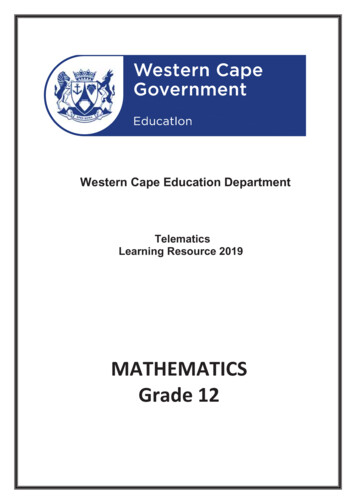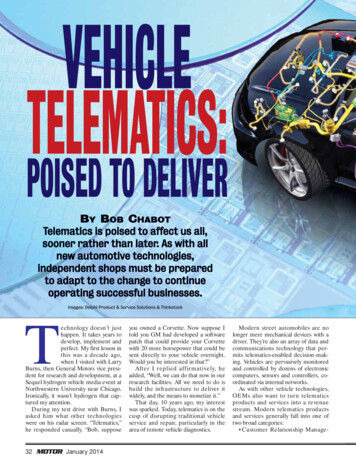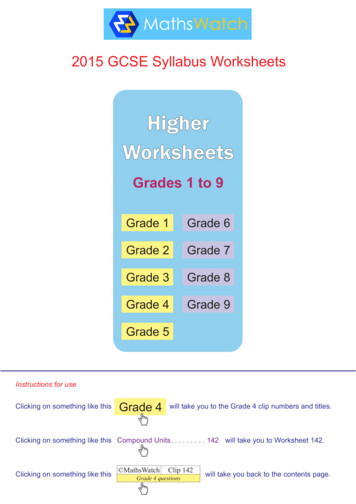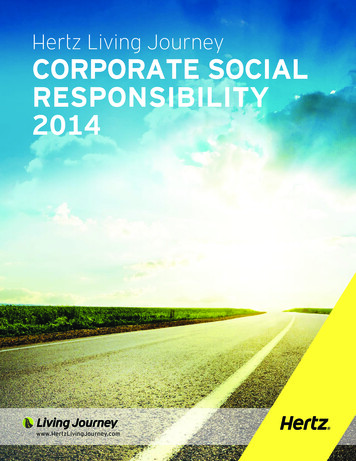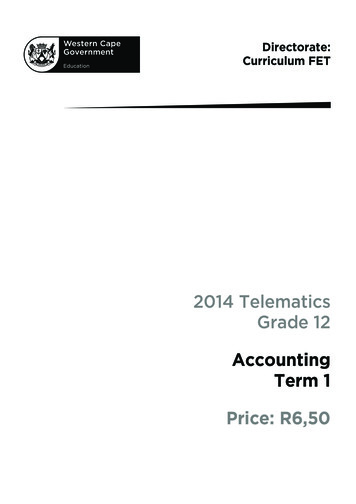
Transcription
Directorate:Curriculum FET2014 TelematicsGrade 12AccountingTerm 1Price: R6,50Accounting2013 Telematics Grade 121
Dear Grade 12 Accounting learnerWelcome to the Telematics project. This programme will support your revision and studyprogramme in preparation for your final Grade 12 Accounting examination.This is an opportunity for you to consolidate what you have been taught in class. Pleasemake use of this opportunity by attending each session. The presenters will not necessarilyaddress all the content areas – they will however focus on more challenging topics in thecurriculum in order to improve your understanding thereof.Tips for success in AccountingIn order to succeed in Accounting you need to take heed of the following: Start working from day 1 Pay careful attention in class to ensure that you understand Complete Accounting homework/exercises dailyPRACTICE PRACTICE PRACTICE Work neatly and accurately Show calculations in brackets Read instructions to questions/activities carefully to ensure you know what is beingasked Complete tasks and assessment activities including tests diligently as if preparingfor your final examination Use past examination papers and tests for revision Refine your examination technique: when you revise, choose questions that willextend you in your weaker areas. Use the time allocations provided in the questionto judge whether you are completing the question in the time available.All the best with your Grade 12 school year.Glynis SchreuderSenior Curriculum Planner: Accounting222014 Telematics Grade 12Accounting
TELEMATICS TEACHING - 2014ACCOUNTING TIME TABLE – GRADE 12 (Term 1)DateTopicBy the end of this lesson you should know:Monday24 February16:00 – 17:00CompaniesHow to record transactions in the General Ledger.These include: Issue of shares Buy-back of shares Provisional tax payments Interim and final dividendsThursday13 March16:00 – 17:00Companies General ledger Cash FlowStatement The purpose of preparing a Cash FlowStatementWhere to find the information in order toprepare a Cash Flow StatementThe three types of activities reflected in aCash Flow StatementWhere to find the informationHow to use the informationHow to prepare sections of a Cash FlowStatement3Accounting2014 Telematics Grade 123
TELEMATICS TEACHING 2014COMPANIESThe purpose ofpreparing a CashFlow StatementThe three types ofactivities reflected ina Cash FlowStatementThe purpose ofpreparing an IncomeStatementThe purpose ofpreparing a BalanceSheet442014 Telematics Grade 12Accounting
Activity 1You are provided with information relating to Kromboom Ltd who has an authorised share capital of1 000 000 shares.REQUIRED:1.1Use the given information to prepare the following accounts in the General ledger forthe accounting period ended 31 August 2013.1.1.11.1.21.1.31.1.41.1.51.1.61.2Ordinary share capitalRetained incomeSARS (Income tax)Shareholders for dividendsDividends on ordinary sharesAppropriation accountPrepare the following notes to the Balance Sheet1.2.1 Ordinary share capital1.2.2 Retained incomeINFORMATION:1 Sep 2012The following balances appeared in the ledger:Ordinary share capital (500 000 shares)Retained incomeSARS (Income tax)Shareholders for dividendsR1 500 0005 260 00070 000 (Cr)325 00014 Sep 2012The amounts due to SARS and the shareholders were paid.20 Jan 2013The company paid a provisional tax of R420 000 and interim dividends of 75cents per share.1 March 2013The company issued a further 100 000 ordinary shares at R15,00 each. Theproceeds of the issue were received.18 July 2013One of the shareholders passed away. The directors decided to buy back his180 000 shares at R20,00 per share. A direct transfer was put through for this.31 Aug 2013At the end of the accounting period, the company made a second provisionaltax payment of R485 000 and the directors declared a final dividends of 160cents per share. All shareholders at this date were eligible for this finaldividend.31 Aug 2013The net income according to the profit and loss account was R2 900 000.Income tax is calculated at 30% of the net income.5Accounting2014 Telematics Grade 125
Activity 2You are provided with information relating to Tuscany Ltd who has an authorised share capital of5 000 000 shares.REQUIRED:2.1Use the following information to prepare the following accounts in the General ledgerfor the accounting period ended 31 December 2013.2.1.12.1.22.1.32.1.42.1.52.1.62.2Ordinary share capitalRetained incomeSARS (Income tax)Shareholders for dividendsDividends on ordinary sharesAppropriation accountPrepare the following notes to the Balance Sheet2.2.1 Ordinary share capital2.2.2 Retained incomeINFORMATION:1 Jan 2013The following balances appeared in the ledger:Ordinary share capital (2 400 000 shares)Retained incomeSARS (Income tax)Shareholders for dividendsR4 800 000960 00016 500 (Cr)210 0001 Jan 2013The company issued a further 1 350 000 shares at R4,50 each. The proceedsof the issue were deposited.15 Jan 2013The amounts due to SARS and the shareholders were paid.30 March 2013 The company paid a provisional tax of R345 000 and interim dividends of 22cents per share.31 Oct 2013The company made a second provisional tax payment of R570 000.15 Nov 2013The directors decided to repurchase 300 000 shares from a disgruntledshareholder at R4,20 per share. A cheque was issued to him.31 Dec 2013At the end of the financial period the directors declared a final dividend of 33cents per share.The net income before tax for the year was calculated at R2 950 000. Incometax is calculated at 30% of the net profit before tax.662014 Telematics Grade 12Accounting
Activity 3You are provided with information relating to Derby Ltd.REQUIRED:3.1Complete the note for reconciliation between profit before taxation and cashgenerated from operations.3.2Complete the Cash Flow Statement for the year ended 31 December 2013INFORMATION:DERBY LTDBALANCE SHEET ON 31 DECEMBER 2013ASSETS20132012Non-current assets4 140 0002 760 000Fixed assets3 552 0002 532 000588 000228 0001 740 0001 804 8001 094 4001 392 000Trade and other receivables156 000324 000Cash and cash equivalents489 60088 8005 880 0004 564 8003 993 6002 142 800Ordinary share capital2556 0001 440 000Retained income1 437 600702 800804 000960 000804 000960 0001 082 4001 432 0001 082 4001 432 0005 880 0004 564 800Financial assetsCurrent assetsInventoriesTOTAL ASSETSSHAREHOLDERS’ EQUITY AND LIABILITIESOrdinary shareholders’ equityNon-current liabilitiesLoan from Hero BankCurrent liabilitiesTrade and other payablesTOTAL EQUITY AND LIABILITIES7Accounting2014 Telematics Grade 127
NOTES TO FINANCIAL STATEMENTS1.TRADE AND OTHER RECEIVABLES2013Trade debtors121 200Income receivable4 800SARS (Income tax)2.30 000CASH AND CASH EQUIVALENTSCash in bankCash float3.312 00012 0000156 000324 000453 60072 80012 000024 000Petty cash201216 000489 60088 800Trade creditors310 800778 000Shareholders for dividends753 600432 0001 082 4001 462 000TRADE AND OTHER PAYABLESIncome received in advance18 000SARS (Income tax)084 000168 000Additional information1.The net profit before tax is R2 480 160.2.Income tax for the year amounted to R692 0003.Dividends for the 2013 financial year consisted of: Interim dividendsR263 760 Final dividendsR753 6004.Depreciation for the year as in the Income Statement5.Derby Ltd paid R27 360 per month to Club Bank which included interest and loanrepayments. Interest is capitalised to the loan.6.A vehicle was sold at book value: Cost price Accumulated depreciation7.Details of share capital The authorised share capital comprised of 3 000 000 shares On 1 January 2013 there were 360 000 ordinary shares in issue. On this same daythe directors decided to repurchase 36 000 ordinary shares from a disgruntledshareholder at a price of 500 cents per share. On 31 December 2013 the company issued 150 000 new shares at a price of 840cents each.R348 000R226 000R152 000882014 Telematics Grade 12Accounting
Activity 4You are provided with an incomplete Cash Flow Statement of HILLSIDE LTD. You are required toprovide the missing figures denoted (a) to (o).HILLSIDE LIMITEDCASH FLOW STATEMENT FOR THE YEAR ENDED 30 JUNE 2013Cash effects of operating activitiesaCash generated from operationsbInterest paidcDividends paiddIncome tax paid(115 400)Cash effects of investing activitiesePurchase of non-current assetsfSale of non-current assets28 800Changes in financial assetsgCash effects of financing activitieshProceeds of shares issuediRepayment of long term loans(200 000)Net change in cash and cash equivalentsjCash and cash equivalents – beginning of year232 000Cash and cash equivalents – end of year184 0009Accounting2014 Telematics Grade 129
NOTES TO THE CASH FLOW STATEMENT FOR THE YEAR ENDED 30 JUNE 2013Reconciliation between net profit before tax and cash generated fromoperationskNet profit before taxAdjustments in respect of:lInterest expenseDepreciation96 320Operating profit before changes in working capitalmCash effects of changes in working capitalnChange in inventory(80 000)Change in debtors68 000Change in creditors76 000Cash generated from operationsoAdditional information:1.100 000 new shares were issued on 1 July 2012 at 960 cents each. There are 250 000shares in issue at the end of the accounting period.2.Income tax is 30% of net profit. At the beginning of the accounting period the company owedR16 400 to SARS and at the end of the period the company owed SARS R12 000.3.The long term loans at the end of the year amounted to R120 000. The R200 000 was paidhalf-way through the year. The interest rate is 15% p.a. and is not capitalised. All interest hasbeen paid on the due date.4.Fixed assets amounted to R3 652 000 at the beginning of the year and R4 602 600 at the endof the year.5.Dividends: Final dividends for 2012 Interim dividends for 2013 Final dividends for 21348 cents per share32 cents per share44 cents per share10102014 Telematics Grade 12Accounting
Directorate:Curriculum FET2014 TelematicsGrade 12AccountingTerm 2 and 3Accounting2014 Telematics Grade 121
Dear Grade 12 Accounting learnerDuring the first term the presenters of this programme dealt with Companies and inparticular the recording of transactions relating to the issue and repurchase of shares,dividends and income tax; and the preparation of the Cash Flow Statement.During the next two sessions the presenters will deal with Inventories, Reconciliations andManufacturing. They will only cover some aspects in these important topics. You areencouraged to work through the questions provided in this resource and to ensure that youunderstand the concepts dealt with. This programme will support your revision and studyprogramme in preparation for your final Grade 12 Accounting examination.This is an opportunity for you to consolidate what you have been taught in class. Pleasemake use of this opportunity by attending each session.Tips for success in AccountingIn order to succeed in Accounting you need to take heed of the following: Pay careful attention in class to ensure that you understand Complete Accounting homework/exercises dailyPRACTICE PRACTICE PRACTICE Work neatly and accurately Show calculations in brackets Read instructions to questions/activities carefully to ensure you know what is beingasked Complete tasks and assessment activities including tests diligently as if preparingfor your final examination Use past examination papers and tests for revision Refine your examination technique: when you revise, choose questions that willextend you in your weaker areas. Use the time allocations provided in the questionto judge whether you are completing the question in the time available.All the best with your revision and preparation for the final examination.Glynis SchreuderSenior Curriculum Planner: Accounting222014 Telematics Grade 12Accounting
Accounting2014 Telematics Grade 12316:00 – 17:00AccountingAccountingWednesday14 MayWednesday4 June16:00 – 17:00TimeDateACCOUNTING TIME TABLE – GRADE 12TELEMATIC TEACHING - 2014Validate and calculate inventoriesFirst-in-first out (FIFO) methodWeighted average methodSpecific identification method3Analysis and interpretation of bank, debtors’and creditors’ reconciliations Reconcile creditors’ statements withtheir personal accounts Reconcile debtors’ and creditors’ listswith control accounts Analyse and interpret debtors’ ageanalysis Analyse and interpret bank statementsand bank reconciliation statementsReconciliations Inventory systemsTopic How to reconcile the creditors’account in Creditors’ Ledger with thestatement received from the creditorThe difference between theperpetual inventory system and theperiodic inventory systemThe difference between FIFO,weighted average and specificidentification methodsHow to valuate inventories using theFIFO method and weighted averagemethodsCalculate and interpret financialindicators related to inventoriesBy the end of this lesson you shouldknow:
42014 Telematics Grade 12AccountingFriday1 AugustDateAccounting16:00 – 17:00Time 4Prepare Production Cost Statementwith notesCalculation of variable and fixed costsCalculation of costs per unitCalculation and interpretation of breakeven pointManufacturingTopic How to prepare a Production CostStatement with notesHow to calculate and interpret breakeven pointHow to calculate and interpret unitcostsBy the end of this lesson you shouldknow:
TELEMATICS TEACHING 2014INVENTORY SYSTEMSPerpetual inventorysystemPeriodic inventorysystemStock valuation methodsFIFO methodWeighted averagemethodSpecific identificationmethodFinancial indicatorsrelated to inventories5Accounting2014 Telematics Grade 125
Activity 1You are provided with information relating to Gary’s Golf Ball Shop for the year ended 28 February2014. The Golf balls are imported and all are identical. The business uses the periodic stocksystem.Information:Golf balls on hand on 1 March 2013Number ofballs250Purchases:25 000Golf balls on hand on 28 February20142 450Purchased on 15 March 2013Purchased on 27 April 2013Purchased on 12 August 2013Purchased on 18 January 2014Purchased on 22 February 2014Sales during the year1 0006 0009 0007 0002 R20,00R21,00R28,00R2,00R2,00R2,50R3,90R4,70?TotalR 4 500R571 200R18 000R111 000R202 500R174 300R65 400?R738 720Required:1.1Calculate the following using the FIFO method of valuing stock: The value of the closing stock on 28 February 2014 The cost of sales The gross profit1.2Calculate the following using the weighted average method of valuing stock: The value of the closing stock on 28 February 2014 The cost of sales The gross profit1.3Calculate the following based on the FIFO method of valuing stock: Mark up % achieved Stock turnover rate Stock holding period1.4Calculate the following based on the weighted average method of valuing stock: Mark up % achieved Stock turnover rate Stock holding period1.5Prepare the Trading account in the Final Accounts Section of the General Ledger of Gary’sGolf Ball Shop. Use the closing stock value based on the FIFO method.662014 Telematics Grade 12Accounting
Activity 2You are provided with information relating to Protea Traders, owned by Deon de Villiers, for thefinancial year ended 28 February 2014. The business is situated in Cape Town.Deon buys and sells cricket balls and jerseys. The business uses the periodic inventorysystem.The cricket balls are bought from South African suppliers, and the cricket bats of different clubsand countries are imported from overseas.Deon employs salespersons to control each item of stock: Jack controls and sells the cricket balls Charl controls and sells the cricket batsDeon has decided on the following accounting policies for valuing inventory: Cricket balls – Weighted-average method Cricket bats – First-in-first-out method (FIFO)REQUIRED:2.1Although this business has done well, Deon is considering closing it down andinvesting his capital in fixed property. State TWO points that he should considerbefore making a final decision.(4)2.2Deon suspects that a number of cricket balls have been shoplifted. Calculate thenumber of balls stolen.(5)2.3Use the relevant information to calculate the closing stock value of: Cricket balls (using the weighted-average method) Cricket bats (using the FIFO method)Show your workings to earn part-marks.2.4Calculate the following for cricket bats (you may prepare a Trading Account tocalculate these figures): 2.5(6)(5)Cost of salesMark-up % on costStock turnover rateIf Deon decides to continue with this business, what advice would you offer him?State TWO points and quote financial indicators or specific information from thequestion to support your answer.(4)(5)(5)(6)7Accounting2014 Telematics Grade 127
INFORMATION:1.Inventories:The stocks were valued as follows at the beginning and end of the financial year:Cricket balls2.Cricket batsDateNo. ofunitsPerunitTotalvalueNo. ofunitsPerunitTotalvalue01/03/20131 200R120R144 000520R320R166 40028/02/2014900?250?Purchases:During the financial year ended 28 February 2012, the following stock items werepurchased:Date ofpurchasesCricket ballsCricket batsNo. ofunitsPerunit31/03/20131 300R120R156 000400R200R 80 00030/06/2013900R150R135 000600R225R135 00030/09/20131 000R175R175 0001 400R255R357 00002/01/2014200R180R 36 000100R300R 30 000Totals3 400TotalvalueNo. ofunitsR502 000Perunit2 500TotalvalueR602 0003.Carriage on purchases:During the year, the business paid a total of R30 200 to transport cricket balls to theshop. The price of the cricket bats includes carriage.4.Sales:5.Financial indicators:ItemsCricket ballsCricket batsItemsCricket ballsCricket batsDetails3 500 units at R320 each2 770 units at R400 eachMark-up % on cost48,5%?TotalR1 120 000R1 108 000Stock turnover rate3,9 times p.a.? times p.a.882014 Telematics Grade 12Accounting
Activity 3Problem-solvingYou are provided with information relating to Fitt World for the year ended 28 February 2014.The business is owned by Fiona Fitt. They sell energy drinks, energy bars and T-shirts toretailers. Fiona employs Cheryl to manage the energy drinks, Kelly to manage the energy barsand Tiffany to manage the T-shirts.Fiona is concerned that her business could have been operating a lot more efficiently. Sheapproaches you for advice.REQUIRED:Identify a problem in respect of the manner in which Cheryl, Kelly and Tiffany have beenmanaging their products. Quote figures or financial indicators to support your answer. GiveFiona ONE suggestion in respect of each product in order to address the problem identified inorder to improve the overall financial results.ManagerProductWorking days per yearDays worked by managerOrders receivedSalesOpening stockPurchasesClosing stockUnits written offGross profitMark-up %Turnover rate of stockPeriod of stock on handCherylKellyEnergy drinksEnergy bars240 days240 days2 7003204 8002 40020T-shirts240 days240 days28 000 units7 000 units330 days2 700 unitsUnitsTiffanyAmountUnitsR52 65028 000R58 56031 800R2 880400?200R210?180 daysAmountR224 000R2 400R201 000R1 263?R45 86325,7%?97 times177 days4 daysUnits3 5003003 20000AmountR73 500R4 500R48 000R0R0R21 00040,0%23 times16 days(18)9Accounting2014 Telematics Grade 129
Activity 4Joshua Gibbons purchases goods on credit from Rajan Traders.REQUIRED:Prepare the Creditors Reconciliation Statement in the books of Joshua on 31 May 2013.INFORMATION:On the 31 May 2013 the following account of Rajan Traders appeared in the Creditors ledger ofJoshua.Creditors Ledger of JoshuaRajan TradersFOL: CL5DRCRBalanceDate2013May1Account renderedB/D11 000 Cr4Cheque 1234CPJ510 450550Discount receivedCPJ5550010 Invoice 1140CJ58 4008 40016 Debit Note 56CAJ52 6005 80031 Invoice 1296CJ51 2007 000Cheque 1335CPJ55 8001 200Joshua received the following monthly statement by post from Rajan Traders on 2 June 2013:Statement of AccountTelFaxDateMay 10Rajan Traders23 Valley View RoadPinetown3610031-267 1551031-267 1600Customers Details:Account No: 111Joshua GibbonsP.O. Box 1019Westville363114101619Date: 25 May 2013DRAccounts renderedPayment – Cheque No: 1234Purchases – Invoice 1140Returns – Debit Note No: 56Purchases – Invoice 11827 5602 6001 000CR10 450Balance11 000 Cr5508 11010 71011 710NOTE: This statement includes all purchases and payments up to and including the 25th of thecurrent month.10102014 Telematics Grade 12Accounting
When comparing the Creditors Ledger against the statement of account the following differenceswere noted:1Rajan Traders forgot to record the discount for early settlement of account by Joshua on 4 thMay 2013.2Invoice No. 1182 shown on the statement of account on 19th May 2013 was in fact forpurchases made by Polo Traders (not Joshua).3Rajan Traders granted Joshua a trade discount of 10% on invoice no 1140.4Rajan Traders made an error in the processing of debit note no 56.All other entries in the Creditors Ledger and on the statement of account were correct.11Accounting2014 Telematics Grade 1211
Activity 5Siengo Traders purchases goods on credit from Mighty Suppliers. The statement received fromMighty Suppliers dated 25 February 2014 reflects that Siengo Traders owes them R111 300. TheCreditors Ledger in the books of Siengo Traders reflects that they owe Mighty Suppliers R71 710.REQUIRED:Use the table below to indicate how the differences between the Creditors Statement and theCreditors Ledger would be handled in order to calculate the correct balance at the end of themonth. Use a ‘ ’ or a ‘-‘ to indicate whether the figure would be added or subtracted.INFORMATIONOn investigation the following were discovered:1. A cheque payment of R25 200 was not reflected on the statement. It was discovered thatthis was a payment by Siengo Traders to Smallfry Suppliers.2. Invoice F89 for R63 000 dated 27 February was not reflected on the statement receivedfrom Mighty Suppliers.3. Invoice F102 appeared on the statement as R2 080 This amount was entered in theCreditors’ Journal as R2 800. The statement is correct.4. A cheque payment of R54 720 to Mighty Suppliers dated 28 February 2014 was notreflected on their statement. Siengo Traders are entitled to a 5% settlement discount.Siengo Traders deducted the 5% from the amount settled before making out the cheque.5. The bookkeeper of Siengo Traders made a posting error to the account in the creditors’ledger. A debit note on 4 February of R660 was treated as a credit instead of a debit.6. Invoice F233 for R19 800 dated 6 February was reflected on the statement but not in thebooks of Siengo Traders. On investigation it appears that Mighty Suppliers have made theerror. The goods were sold to one of their other customers.7. Siengo Traders returned goods to the value of R2 030 per debit note DN125 dated 27February 2014 but this was not reflected on the statement.12122014 Telematics Grade 12Accounting
Activity 6Glen Tables Manufacturers produce wooden dining-room tables. The business is owned byGlen Mabaso.REQUIRED:6.1Refer to Information H below. Calculate the Direct Labour Cost for the month.6.2Prepare the Production Cost Statement for the month ended 31 July 2013, with aseparate note for Factory Overhead Cost. Show ALL other workings in brackets.6.3Calculate the unit cost of the production of 410 completed tables (finished goods) forJuly 2013.6.4Glen is concerned about the control over certain costs. Direct materials account formore than 40% of the cost of one table, while direct labour accounts for more than30%. Glen wants your advice. Make TWO suggestions on how to improve efficiency in the use of directmaterials. Make TWO suggestions on how to improve the efficiency of the directlabourers.INFORMATION FOR JULY 2013:A.Stocks on hand at the beginning and end of the month.1 July 2013R40 000R55 000NilNilRaw materials stockWork-in-progressFinished goodsIndirect materials31 July 2013R65 000R40 000NilNilB.Raw materials purchased on credit, R180 000C.Depreciation is as follows: Factory plant, R7 400 Office equipment, R2 400D.Factory maintenance paid in July, R8 000. A further amount of R3 500 is owed forrepairs to a machine.E.Electricity and water paid amount to R4 600 for July. The administration office uses10% of this and the factory uses the rest.F.Rent and insurance are allocated between the factory and the administration office onthe basis of floor area. The factory comprises 630 square metres, while the officecomprises 270 square metres. The monthly rent for the entire premises is R30 000.The annual insurance premium is R43 200.13Accounting2014 Telematics Grade 1213
G.Indirect materials bought for cash, R20 000. There was no stock of indirect materialson hand at the end of the month. The factory uses 75% of these materials, while theoffice uses the rest.H.Direct labour and production:The 15 factory workers who make the tables each work 9 hours per day. The normalrate is R36 per hour per person.There were normally 20 working days in a month. However, due to power cuts, thefactory could operate for only 14 week days in July 2013.In order to make up for lost time, the 15 factory workers each worked 45 hoursovertime on weekends. The overtime rate is double the normal rate.However, they were unable to meet their target production of 450 tables per month.They managed to complete 410 tables. The break-even point is 320 tables.I.Other salaries and wages comprise: The factory cleaner earns R2 600 per month The factory foreman earns R15 000 per month. The bookkeeper had forgottento process the foreman's pension. The employees' pension deduction is 7%and the employer's contribution is 10%. The contributions are added to thesalaries account. The administration staff earn R13 000 per month in total.J.The selling price of each table is set at cost of production plus R500 gross profit pertable.K.The two salespersons work from home on a commission basis. The business incursno fixed costs in this regard.14142014 Telematics Grade 12Accounting
Directorate:Curriculum FET2014 TelematicsGrade 12AccountingWorkbookTerm 1Accounting2014 Telematics Grade 121
Activity 1GENERAL LEDGER OF KROMBOOM LTD1.1.1Ordinary share capital1.1.2Retained income1.1.3SARS (Income tax)222014 Telematics Grade 12Accounting
1.1.4Shareholders for dividends1.1.5Dividends on ordinary shares1.1.6Appropriation account3Accounting2014 Telematics Grade 123
1.2KROMBOOM LTDNOTES TO THE BALANCE SHEETRETAINED INCOMEBalance at beginning of yearNet profit after taxRepurchase of 100 000 ordinary sharesDividendsPaidRecommendedBalance at end of yearORDINARY SHARE CAPITALAuthorisedIssued442014 Telematics Grade 12Accounting
Activity 2GENERAL LEDGER OF TUSCANY LTD2.1.1Ordinary share capital2.1.2Retained income2.1.3SARS (Income tax)5Accounting2014 Telematics Grade 125
2.1.4Shareholders for dividends2.1.5Dividends on ordinary shares2.1.6Appropriation account662014 Telematics Grade 12Accounting
2.2TUSCANY LTDNOTES TO THE BALANCE SHEETRETAINED INCOMEORDINARY SHARE CAPITALAuthorisedIssued7Accounting2014 Telematics Grade 127
Activity 3DERBY LTD3.1RECONCILIATION BETWEEN NET PROFIT BEFORE TAX AND CASHGENERATED FROM OPERATIONSNet profit before taxOperating profit before changes in working capitalCash effects of changes in working capitalChange in inventoryCash generated from operations882014 Telematics Grade 12Accounting
3.2DERBY LIMITEDCASH FLOW STATEMENT FOR THE YEAR ENDED 31 DECEMBER 2013Cash effects of operating activitiesCash generated from operationsCash effects of investing activitiesPurchase of fixed assetsCash effects of financing activitiesProceeds of issue of sharesRepayment of long-term loanNet change in cash and cash equivalentsCash and cash equivalents – beginning of yearCash and cash equivalents – end of year9Accounting2014 Telematics Grade 129
Activity 4You are provided with an incomplete Cash Flow Statement of HILLSIDE LTD. You are required toprovide the missing figures denoted (a) to (o).HILLSIDE LIMITEDCASH FLOW STATEMENT FOR THE YEAR ENDED 30 JUNE 2013Cash effects of operating activitiesaCash generated from operationsbInterest paidcDividends paiddIncome tax paid(115 400)Cash effects of investing activitiesePurchase of non-current assetsfSale of non-current assets28 800Changes in financial assetsgCash effects of financing activitieshProceeds of shares issuediRepayment of long term loans(200 000)Net change in cash and cash equivalentsjCash and cash equivalents – beginning of year232 000Cash and cash equivalents – end of year184 00010102014 Telematics Grade 12Accounting
NOTES TO THE CASH FLOW STATEMENT FOR THE YEAR ENDED 30 JUNE 2013Reconciliation between net profit before tax and cash generated from operationsNet profit before taxkAdjustments in respect of:lInterest expenseDepreciation96 320Operating profit before changes in working capitalmCash effects of changes in working capitalnChange in inventory(80 000)Change in debtors68 000Change in creditors76 000Cash generated from operationsoCalculations:11Accounting2014 Telematics Grade 1211
122014 Telematics Grade 12Accounting
Directorate:Curriculum FET2014 TelematicsGrade 12AccountingWorkbookTerm 2 and 3Accounting2014 Telematics Grade 121
Activity 11.1FIFO method1.2Calculate the cost of sales.Calculate the cost of sales.Calculate the gross profitCalculate the gross profitCalculate the value of the closing stock.Weighted average methodCalculate the value of the closingstock.222014 Telematics Grade 12Accounting
1.3FIFO methodCalculate the mark up % achieved1.4 Weighted average methodCalculate the mark up % achievedCalculate the stock turnover rateCalculate the stock turnover rateCalculate the stock holding periodCalculate the stock holding period1.5Trading account3Accounting2014 Telematics Grade 123
Activity 22.1Although this business has done well, Deon is considering closing it down andinvesting his capital in fixed property. State TWO poin
shares in issue at the end of the accounting period. 2. Income tax is 30% of net profit. At the beginning of the accounting period the company owed R16 400 to SARS and at the end of the period the company owed SARS R12 000. 3. The long term loans at the end of the year amounted to R120 000. The R200 000 was paid half-way through the year.
